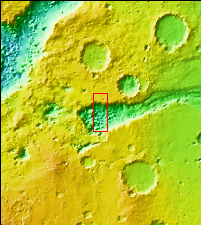
|
Aromatum Chaos
- Click the image above for a larger view
- Full-Res JPEG (685 x 1426) (71.5 kB)
- Full-Res TIFF (685 x 1426) (672.7 kB)
Caption:

Context image
This VIS image shows part of Aronatum Chaos. Aromatum Chaos is a depression about 90 km (56 mi) long by 30 km (20 mi) wide. At it's deepest Aronatum Chaos is 3,500 meters (11,500 ft) below the Xanthe Terra. On average, however, Aromatum is about 1,500 m (4,900 ft) deep. Mars scientists interpret chaos regions as places where groundwater has broken out and undermined the surface, loosening the rocky material and washing it away. Aronatum Chaos is at the head of Ravi Vallis, a 200 kilometers (125 miles) long channel located in Xanthe Terra.
Orbit Number: 78828 Latitude: -1.00608 Longitude: 316.825 Instrument: VIS Captured: 2019-09-22 00:20
Background Info:
Please see the THEMIS Data Citation Note for details on crediting THEMIS images.
NASA's Jet Propulsion Laboratory manages the 2001 Mars Odyssey mission for NASA's Science Mission Directorate, Washington, D.C. The Thermal Emission Imaging System (THEMIS) was developed by Arizona State University, Tempe, in collaboration with Raytheon Santa Barbara Remote Sensing. The THEMIS investigation is led by Dr. Philip Christensen at Arizona State University. Lockheed Martin Astronautics, Denver, is the prime contractor for the Odyssey project, and developed and built the orbiter. Mission operations are conducted jointly from Lockheed Martin and from JPL, a division of the California Institute of Technology in Pasadena.
Cataloging Keywords:
| Name | Value | Additional Values |
|---|---|---|
| Target | Mars | |
| System | ||
| Target Type | Planet | |
| Mission | 2001 Mars Odyssey | |
| Instrument Host | Mars Odyssey | |
| Host Type | Orbiter | |
| Instrument | Thermal Emission Imaging System (THEMIS) | |
| Detector | ||
| Extra Keywords | Grayscale, Thermal, Water | |
| Acquisition Date | ||
| Release Date | 2019-10-30 | |
| Date in Caption | 2019-09-22 | |
| Image Credit | NASA/JPL-Caltech/ASU | |
| Source | photojournal.jpl.nasa.gov/catalog/PIA23523 | |
| Identifier | PIA23523 | |
